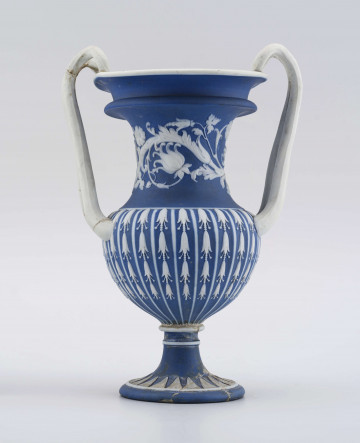
Angular wardrobe
2nd half of the 18th century
National Museum in Lublin
Part of the collection: Faience, ceramic and metal vessels and items
The oval jardiniere is an excellent example of a product made by the family company of Łopieński brothers, existing in Warsaw since 1862, specialising in the production of objects made of bronze, silver and precious metals. In the inter-war period, products of the Warsaw foundrymen were considered to be among the best on the Polish market, which was confirmed, among other things, by awards at exhibitions at home and abroad.
The beginnings of the company date back to 1862, when Jan Łopieński founded a bronzing, chiselling and casting workshop in Warsaw. At that time, the company specialised in manufacturing silver products, including sacred silver, ciboria, liturgical tins, chalices, candlesticks, and candelabra. Łopieński was an extremely talented artist who gained his education and mastery while studying in Krakow, Vienna and Paris. Unfortunately, in 1880, the company went bankrupt, and Jan Łopieński found employment at the Norblin Plater Factory. After four years, the company was reactivated by Jan's sons, Grzegorz, who took care of the technical and artistic side of the venture, and Feliks, who focussed on the plant's finances. Initially, the re-established company operated under the name Fabryka Wyrobów Bronzowych G. Łopieński – Warszawa (Bronzeware Factory G. Łopieński –Warsaw), but it was relatively quickly changed to ‘Łopieńscy Brothers’. In 1900, the company headquarters were moved to a new factory complex in Hoża Street. Already in 1912, as the popularity of their products grew, the Łopieński brothers could afford to build another production hall equipped with, among others, a modern Morgan furnace imported from Great Britain.
At the beginning of the 20th century in Warsaw, despite the competition of nearly one hundred and forty establishments producing bronze products, Łopieński's factory remained the largest company of its kind in the pre-war capital and invariably enjoyed the most outstanding reputation.
In 1950, the company was nationalised and transformed into a cooperative called ‘Bronze Decoration’. At that time, work was underway in Warsaw to restore the Fryderyk Chopin monument in the Royal Łazienki Park. At that time, Tadeusz Łopieński was employed in the cooperative as the artistic and technical manager and Władysław as the tinkerer. After completing the casting of the monument, both brothers were dismissed from their jobs with a lifetime ban.
Author / creator
Dimensions
cały obiekt: height: 32 cm, width: 11,7 cm
Object type
furnishings and equipment
Technique
patination
Material
glass, brass
Creation time / dating
Creation / finding place
Owner
The National Museum in Lublin
Identification number
Location / status

2nd half of the 18th century
National Museum in Lublin

1882 — 1884
National Museum in Lublin

1800 — 1820
National Museum in Lublin
DISCOVER this TOPIC
National Museum in Lublin
DISCOVER this PATH
Educational path